Companion Diagnostics Market Size
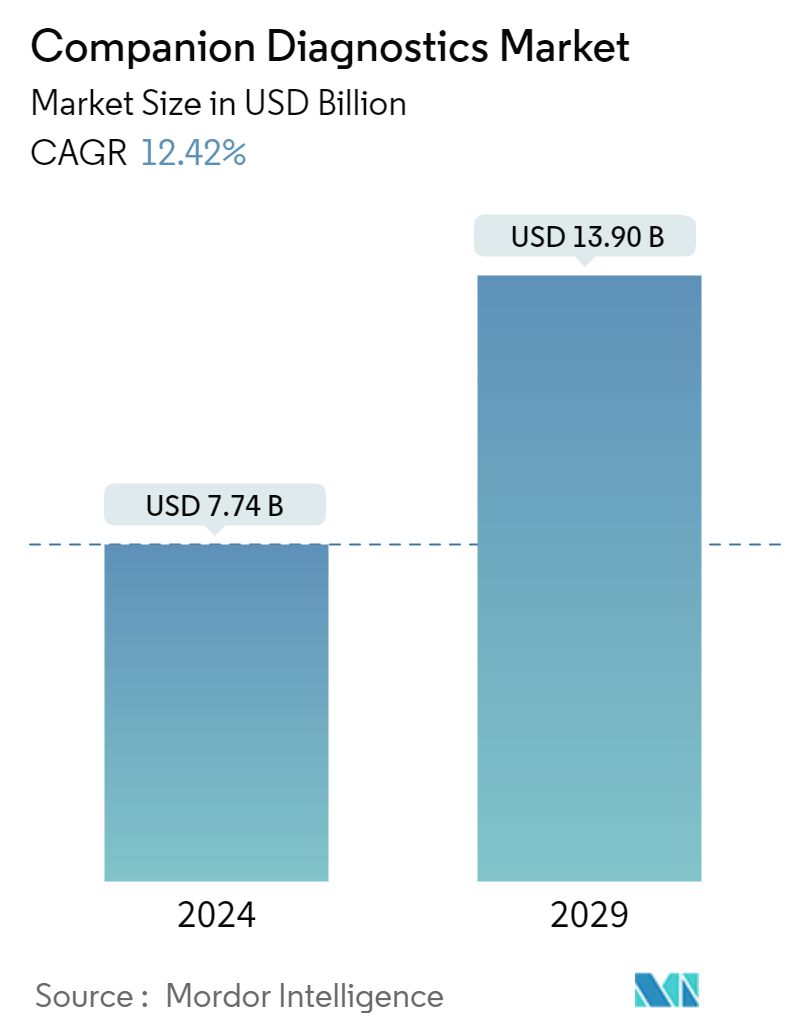
| Study Period | 2019 - 2029 |
| Market Size (2024) | USD 7.74 Billion |
| Market Size (2029) | USD 13.90 Billion |
| CAGR (2024 - 2029) | 12.42 % |
| Fastest Growing Market | Asia-Pacific |
| Largest Market | North America |
Major Players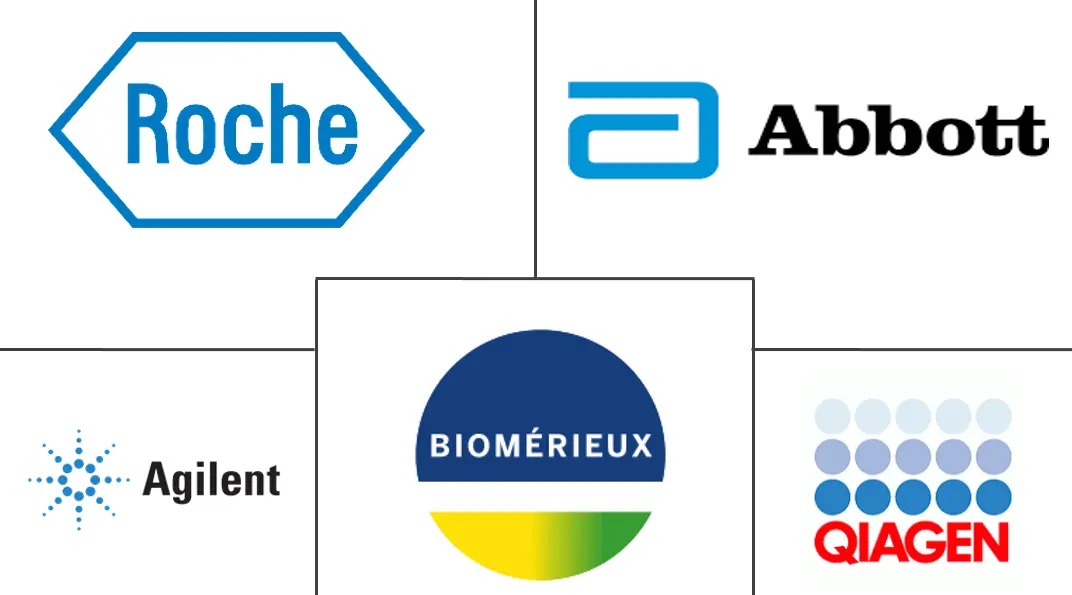
*Disclaimer: Major Players sorted in no particular order |
Companion Diagnostics Market Analysis
The Companion Diagnostics Market size is estimated at USD 7.74 billion in 2024, and is expected to reach USD 13.90 billion by 2029, growing at a CAGR of 12.42% during the forecast period (2024-2029).
The promotion of personalized medicine and targeted therapy as a new treatment option by key players, increasing cases of adverse drug reactions, and the development of new drug and diagnostic technology are expected to boost the market’s growth over the forecast period.
The increasing focus on personalized medicine product approvals and new technology development is propelling the market’s growth. For instance, according to an article published by Healthcare Radius in January 2023, companion diagnostics were observed to be integral to the rising focus on personalized medicine, enabling targeted treatment by identifying specific genetic markers associated with diseases. Their role in co-developing drug and diagnostic technologies ensures a synergistic approach to treatment, maximizing efficacy and minimizing adverse effects. Thus, the benefits offered by companion diagnostics are expected to increase their adoption for treating cancer patients globally.
The increasing cases of adverse drug reactions due to medication inefficacy also drive the need for companion diagnostics in the market, thus aligning therapeutic approaches with patients' genetic profiles to optimize treatment outcomes. For instance, according to an article published by Healthcare Radius in January 2023, companion diagnostics offer a strategic approach to mitigate the potential risks associated with drug treatments and help effectively identify patients predisposed to experiencing adverse effects during therapy. This targeted identification enhances patient safety and optimizes treatment outcomes, thus aligning with medical and business objectives within the healthcare industry. Companion diagnostics can help physicians adjust the dosage or switch to a different treatment option, thus improving patients' overall quality of life.
The rising burden of cancer increases the demand and awareness for personalized medicines among the population globally. For instance, according to the report published by the American Cancer Society in January 2024, about 2 million new cancer cases are projected to be diagnosed in the United States in 2024, compared to 1.9 million cases in 2023. Additionally, according to the report by Red Española de Registros de Cáncer published in January 2023, the incidence rate of cancer cases estimated in Spain for 2023 was 279,260. Clinical diagnostics are integral to implementing personalized medicine, thus leveraging individuals' genetic profiles to enhance precision and efficacy in cancer treatment. This approach ensures tailored strategies that align with specific patient needs, fostering optimal outcomes within oncology care.
Companies are strategically enhancing collaborations to advance biomarkers and diagnostic technologies, particularly focusing on cost efficiency and regulatory compliance. This trend has generated numerous opportunities for diagnostic applications in critical medical indications such as cancer, cardiovascular diseases, and neurological disorders. For instance, in January 2024, Agilent Technologies Inc. signed an agreement with Incyte, bringing together Agilent’s expertise in developing companion diagnostics (CDx) to support the development and commercialization of Incyte’s hematology and oncology portfolio. This agreement allows Agilent to expand its companion diagnostics portfolio with novel biomarkers.
Major companies are actively advancing innovative technologies and formulating strategic growth plans to tackle a broader range of unmet needs in cancer care. For instance, in October 2023, Foundation Medicine Inc. received approval from the US Food and Drug Administration for FoundationOneCDx and FoundationOneLiquid CDx to be used as companion diagnostics for Pfizer’s BRAFTOVI (encorafenib) in combination with MEKTOVI (binimetinib) for the treatment of adult patients with metastatic non-small cell lung cancer (NSCLC) with a BRAF V600E mutation.
In February 2023, Roche signed a collaboration with Janssen Biotech Inc. (Janssen) to create companion diagnostics for targeted therapies, further strengthening research and innovation activities.
Thus, the increasing promotion of personalized medicine and targeted therapy by key players, rising cases of adverse drug reactions, and the development of new drug and diagnostic technologies are impacting the companion diagnostics market’s growth. However, the high cost of drug development and associated clinical trials and reimbursement issues among many countries are expected to restrain the market over the forecast period.
Companion Diagnostics Market Trends
The Lung Cancer Segment is Expected to Witness Significant Growth Over the Forecast Period
Companion diagnostic tests (CDXs) are considered mandatory in decision-making for treatment with targeted therapies in lung cancer. Patients with lung cancer who receive companion diagnostics as part of their initial treatment have more survival benefits, such as targeted therapy selection, which helps in providing personalized treatment to the target patient.
The high incidence rate of lung cancer and novel innovations in companion diagnostics by major players are likely to boost the segment's growth over the forecast period.
Globally, the high incidence rate of non-small cell lung cancer (NSCLC), coupled with the growing development of oncology companion diagnostic tests for the disease, is expected to boost the segment's growth. For instance, according to a report published by the American Cancer Society in January 2024, about 10-15% of all lung cancers were observed to be small cell lung cancer (SCLC), and about 80-85% were non-small cell lung cancer (NSCLC). The same source reported an estimated 234,580 new cases of lung cancer in 2024 in the United States, leading to more demand for lung cancer companion diagnostics. Similarly, according to a report published by the American Cancer Society in 2023, about 238,340 people were diagnosed with lung cancer. Such prevalence is expected to fuel the growth of the lung cancer segment in the companion diagnostic market over the forecast period.
The segment is also growing due to the rising number of product approvals and launches. In June 2023, ARUP Laboratories received approval from the US Food and Drug Administration for AAV5 DetectCDx as a companion diagnostic to aid in the selection of adult patients eligible for treatment with ROCTAVIAN (valoctocogene roxaparvovec-rvox).
Companies are also focusing on adopting key collaborative strategies to expand their product portfolios in the market. In July 2023, Tempus collaborated with TScan Therapeutics to develop a companion diagnostic (CDx) test to treat cancer patients. The collaboration supports TScan’s screening protocol for its Phase 1 solid tumor, including non-small cell lung cancer, a clinical trial designed to enable customized mixtures of TCR-Ts to be administered to patients based on tumor antigen positivity and intact HLA expression.
Therefore, the high incidence rate of lung cancer, novel innovations in companion diagnostics by major players, and strategic activities are expected to drive the segment’s growth during the forecast period.
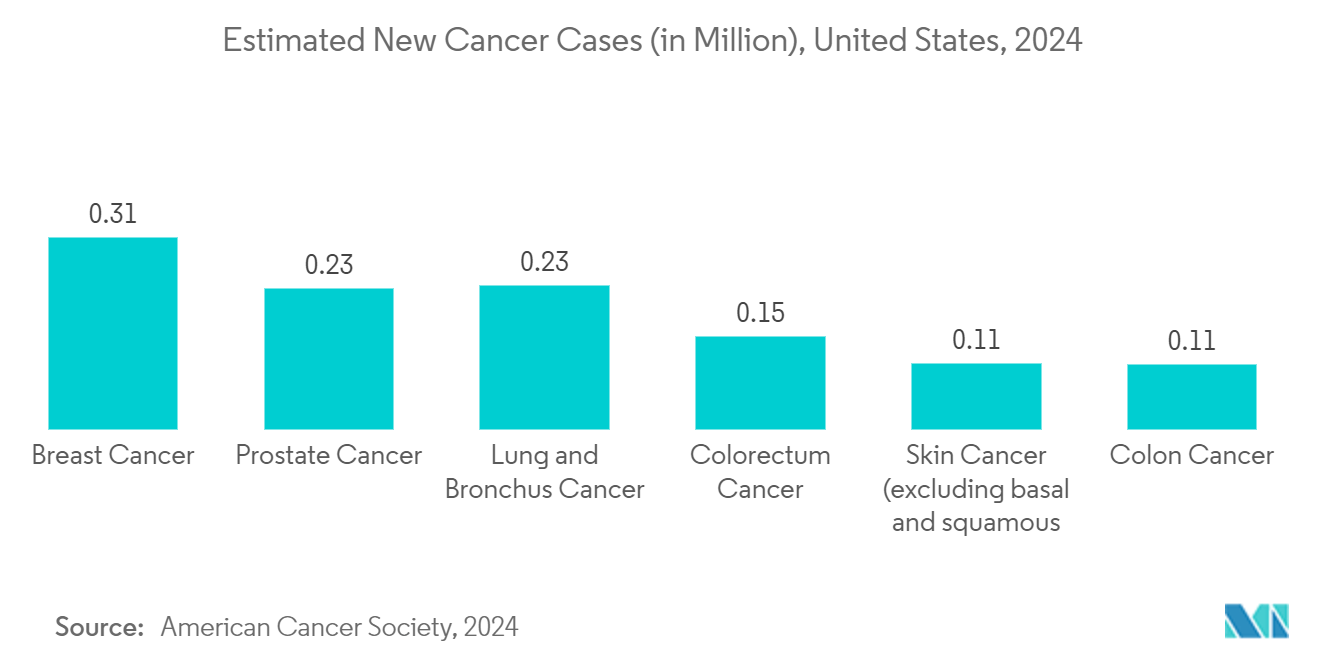
North America is Expected to Hold a Significant Market Share Over the Forecast Period
North America is expected to witness significant growth in the overall companion diagnostics market, with the United States emerging as a key contributor. Companion diagnostics are recognized as pivotal tools for making treatment decisions related to various oncology drugs, as evidenced by the FDA's classification of these assays based on associated risks. This acknowledgment underscores the strategic importance of companion diagnostics in oncology, emphasizing their role as critical elements in informed and risk-assessed treatment decisions.
The increasing burden of cancer in the United States is also expected to drive the market. For instance, according to a report published by the Cancer Journal for Clinicians1 in January 2024, about 313,510 breast cancer cases, 152,810 colorectal cancer cases, and 66,440 pancreatic cancer cases were estimated in the United States in 2024. The incidence of cancer has also been rising in Canada, which is expected to boost the demand for companion diagnostics tests in the market. For instance, according to a report published by Canadian Cancer Statistics in November 2023, about 239,100 new cancer cases were estimated to be diagnosed in Canada in 2023, compared to 233,900 new cancer cases in 2022. This data shows the increasing burden of cancer in the region, which is expected to boost the demand for companion diagnostics.
Product launches, strategic collaborations, partnerships, and product approvals by the government are expected to drive the North American companion diagnostics market over the forecast period. In June 2023, the US FDA initiated a new voluntary pilot program for certain oncology drug products used with certain corresponding in vitro diagnostic tests to help clinicians select appropriate cancer treatments for patients. Similarly, in June 2022, GRAIL LLC, a healthcare company, signed a strategic collaboration with AstraZeneca to develop and commercialize companion diagnostic (CDx) assays for use with AstraZeneca’s therapies. The company focuses on developing companion diagnostic tests to identify patients with high-risk, early-stage disease. Such developments are expected to positively impact the regional market’s growth.
The increasing burden of cancer, rising product launches, and growth strategies by major players are expected to significantly boost the region’s share in the global companion diagnostics market.
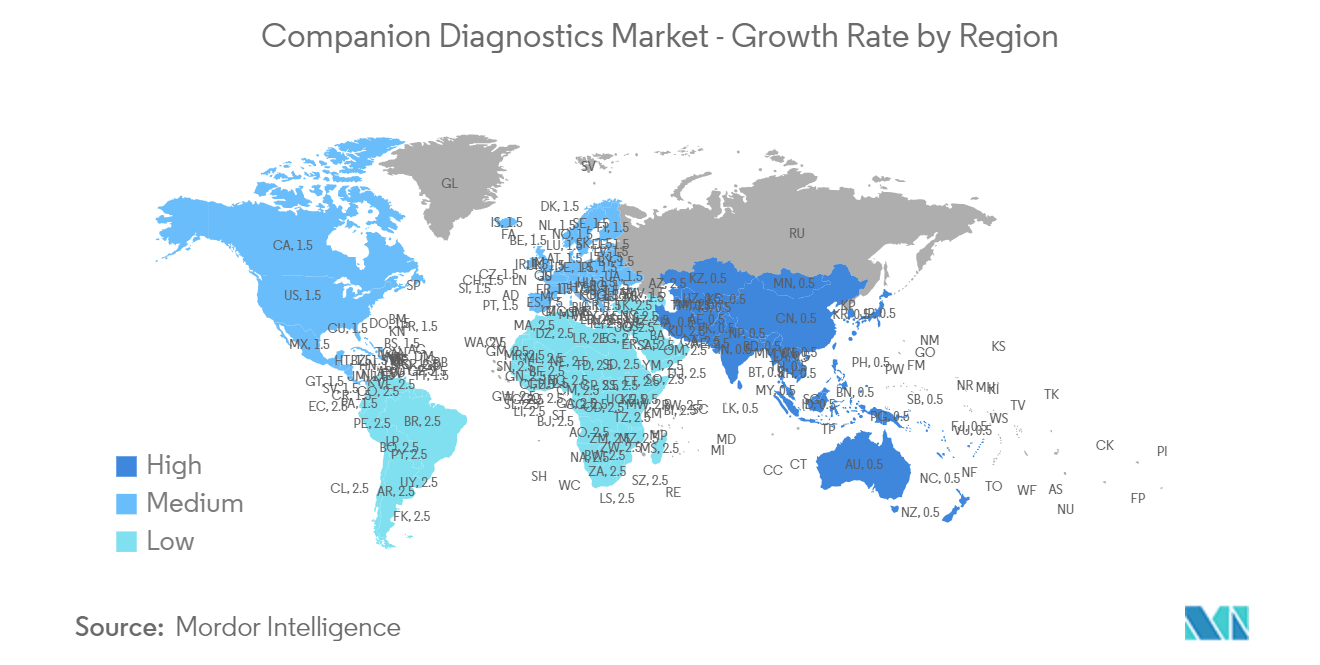
Companion Diagnostics Industry Overview
The companion diagnostics market is highly fragmented and competitive, with several major players. The rising focus of companies on personalized medicine, co-development activities, and increased cases of adverse drug reactions are expected to boost the market's competitive nature. Some of the key players in the market are Abbott, Agilent Technologies Inc., F Hoffmann-La Roche Ltd, Biomerieux, Qiagen NV, and Siemens Healthineers AG.
Companion Diagnostics Market Leaders
-
Qiagen NV
-
Agilent Technologies Inc.
-
Abbott
-
Biomerieux
-
F. Hoffmann-La Roche Ltd
*Disclaimer: Major Players sorted in no particular order
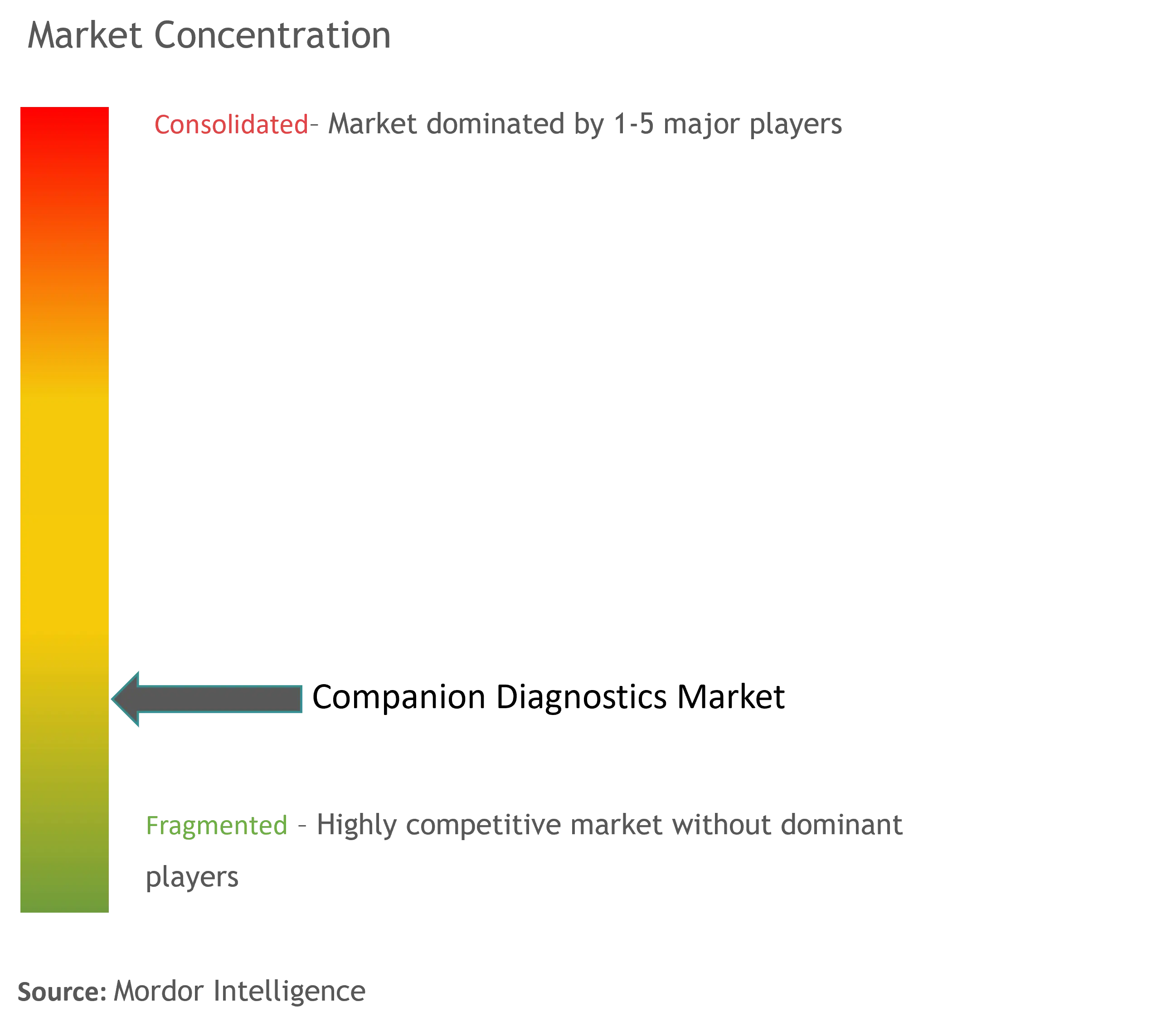
Companion Diagnostics Market News
- April 2024: Roche received approval of the CE Mark for the VENTANA HER2 (4B5) Rabbit Monoclonal Primary Antibody RxDx to identify metastatic breast cancer patients with low HER2 expression who can be given ENHERTU (trastuzumab deruxtecan) as a targeted treatment.
- April 2024: Transcenta Holding Limited collaborated with Agilent Technologies to develop Claudin18.2 (CLDN18.2), a companion diagnostic, to support the TranStar301 global Phase III pivotal trial of Osemitamab (TST001) in combination with Nivolumab and chemotherapy as first-line treatment in patients with CLDN18.2 expressing locally advanced or metastatic gastric or gastroesophageal (G/GEJ) adenocarcinoma.
- February 2024: Roche signed an agreement with PathAI, a global company active in AI-powered technology for pathology. Under the terms of this agreement, PathAI will exclusively work with Roche Tissue Diagnostics (RTD) to develop AI-enabled digital pathology algorithms in the companion diagnostics space.
Companion Diagnostics Market Report - Table of Contents
1. INTRODUCTION
- 1.1 Study Assumptions and Market Definition
- 1.2 Scope of the Study
2. RESEARCH METHODOLOGY
3. EXECUTIVE SUMMARY
4. MARKET DYNAMICS
- 4.1 Market Overview
-
4.2 Market Drivers
- 4.2.1 Companies Promoting Personalized Medicine and Targeted Therapy as a New Treatment Option
- 4.2.2 Increasing Cases of Adverse Drug Reactions
- 4.2.3 Co-development of Drug and Diagnostic Technologies
-
4.3 Market Restraints
- 4.3.1 High Cost of Drug Development and Associated Clinical Trials
- 4.3.2 Reimbursement Issues Among Many Countries
-
4.4 Industry Attractiveness - Porter's Five Forces Analysis
- 4.4.1 Threat of New Entrants
- 4.4.2 Bargaining Power of Buyers/Consumers
- 4.4.3 Bargaining Power of Suppliers
- 4.4.4 Threat of Substitute Products
- 4.4.5 Intensity of Competitive Rivalry
5. MARKET SEGMENTATION (Market Size by Value in USD)
-
5.1 By Technology
- 5.1.1 Immunohistochemistry (IHC)
- 5.1.2 Polymerase Chain Reaction (PCR)
- 5.1.3 In-situ Hybridization (ISH)
- 5.1.4 Real-time PCR (RT-PCR)
- 5.1.5 Gene Sequencing
- 5.1.6 Other Technologies
-
5.2 By Indication
- 5.2.1 Lung Cancer
- 5.2.2 Breast Cancer
- 5.2.3 Colorectal Cancer
- 5.2.4 Leukemia
- 5.2.5 Melanoma
- 5.2.6 Other Indications
-
5.3 By Geography
- 5.3.1 North America
- 5.3.1.1 United States
- 5.3.1.2 Canada
- 5.3.1.3 Mexico
- 5.3.2 Europe
- 5.3.2.1 Germany
- 5.3.2.2 United Kingdom
- 5.3.2.3 France
- 5.3.2.4 Italy
- 5.3.2.5 Spain
- 5.3.2.6 Rest of Europe
- 5.3.3 Asia-Pacific
- 5.3.3.1 China
- 5.3.3.2 Japan
- 5.3.3.3 India
- 5.3.3.4 Australia
- 5.3.3.5 South Korea
- 5.3.3.6 Rest of Asia-Pacific
- 5.3.4 Middle East and Africa
- 5.3.4.1 GCC
- 5.3.4.2 South Africa
- 5.3.4.3 Rest of Middle East and Africa
- 5.3.5 South America
- 5.3.5.1 Brazil
- 5.3.5.2 Argentina
- 5.3.5.3 Rest of South America
6. COMPETITIVE LANDSCAPE
-
6.1 Company Profiles
- 6.1.1 Abbott
- 6.1.2 Agilent Technologies Inc.
- 6.1.3 F.Hoffmann-La Roche Ltd
- 6.1.4 Biomerieux
- 6.1.5 Qiagen NV
- 6.1.6 Siemens Healthineers AG
- 6.1.7 Thermo Fisher Scientific Inc.
- 6.1.8 Danaher Corporation (Beckman Coulter Inc.)
- 6.1.9 Almac Group
- 6.1.10 Illumina Inc.
- 6.1.11 Myriad Genetics Inc.
- 6.1.12 Sysmex Corporation
- 6.1.13 Abnova Corporation
- 6.1.14 Guardant Health Inc.
- 6.1.15 Biogenex Laboratories Inc.
- *List Not Exhaustive
Companion Diagnostics Industry Segmentation
As per the scope of the report, companion diagnostic tests provide information essential for safely and effectively using a corresponding drug or biological product.
The companion diagnostics market is segmented by technology, indication, and geography. The technology segment is divided into immunohistochemistry (IHC), polymerase chain reaction (PCR), in-situ hybridization (ISH), real-time PCR (RT-PCR), gene sequencing, and other technologies. The indication segment is divided into lung cancer, breast cancer, colorectal cancer, leukemia, melanoma, and other indications. The report also covers the estimated market sizes and trends for 17 countries across major regions globally. The report offers the value in USD for these segments.
| By Technology | Immunohistochemistry (IHC) | |
| Polymerase Chain Reaction (PCR) | ||
| In-situ Hybridization (ISH) | ||
| Real-time PCR (RT-PCR) | ||
| Gene Sequencing | ||
| Other Technologies | ||
| By Indication | Lung Cancer | |
| Breast Cancer | ||
| Colorectal Cancer | ||
| Leukemia | ||
| Melanoma | ||
| Other Indications | ||
| By Geography | North America | United States |
| Canada | ||
| Mexico | ||
| By Geography | Europe | Germany |
| United Kingdom | ||
| France | ||
| Italy | ||
| Spain | ||
| Rest of Europe | ||
| By Geography | Asia-Pacific | China |
| Japan | ||
| India | ||
| Australia | ||
| South Korea | ||
| Rest of Asia-Pacific | ||
| By Geography | Middle East and Africa | GCC |
| South Africa | ||
| Rest of Middle East and Africa | ||
| By Geography | South America | Brazil |
| Argentina | ||
| Rest of South America |
Companion Diagnostics Market Research FAQs
How big is the Companion Diagnostics Market?
The Companion Diagnostics Market size is expected to reach USD 7.74 billion in 2024 and grow at a CAGR of 12.42% to reach USD 13.90 billion by 2029.
What is the current Companion Diagnostics Market size?
In 2024, the Companion Diagnostics Market size is expected to reach USD 7.74 billion.
Who are the key players in Companion Diagnostics Market?
Qiagen NV, Agilent Technologies Inc., Abbott, Biomerieux and F. Hoffmann-La Roche Ltd are the major companies operating in the Companion Diagnostics Market.
Which is the fastest growing region in Companion Diagnostics Market?
Asia-Pacific is estimated to grow at the highest CAGR over the forecast period (2024-2029).
Which region has the biggest share in Companion Diagnostics Market?
In 2024, the North America accounts for the largest market share in Companion Diagnostics Market.
What years does this Companion Diagnostics Market cover, and what was the market size in 2023?
In 2023, the Companion Diagnostics Market size was estimated at USD 6.78 billion. The report covers the Companion Diagnostics Market historical market size for years: 2019, 2020, 2021, 2022 and 2023. The report also forecasts the Companion Diagnostics Market size for years: 2024, 2025, 2026, 2027, 2028 and 2029.
What are the future growth prospects for the Companion Diagnostics Market?
The future growth prospects for the Companion Diagnostics Market are a) Growing awareness and acceptance by healthcare professionals b) Demand for companion diagnostics to identify patients who will benefit from specific cancer treatments
What are the future growth prospects for the Companion Diagnostics Market?
The future growth prospects for the Companion Diagnostics Market are a) Growing awareness and acceptance by healthcare professionals b) Demand for companion diagnostics to identify patients who will benefit from specific cancer treatments
Companion Diagnostics Industry Report
The companion diagnostics market is experiencing significant growth due to the increasing adoption of personalized medicine and the rising incidence of cancer globally. This market includes a variety of products such as assays, kits, and software, with a particular emphasis on PCR and NGS technologies. These technologies are especially prominent in cancer care, where they play a crucial role in providing tailored treatments and identifying important biomarkers.
The trend of developing companion diagnostics in tandem with therapeutic products is enhancing drug development processes, improving drug safety, and increasing efficacy. Despite challenges such as the high costs associated with biomarker discovery and a shortage of skilled professionals, the market is dominated by a few major companies. These companies have extensive product ranges and a strong global presence, which gives them a competitive edge.
North America holds the largest market share, driven by technological advancements and a high number of product approvals. The market's growth is further supported by the increasing importance of diagnostic biomarkers among pharmaceutical and biotech companies, as well as reference labs. This underscores the critical role of companion diagnostics in drug development and personalized care.
The market report provides a comprehensive industry analysis, including market size, market growth, and market trends. It offers detailed market segmentation by technology, indication, and geography. The industry outlook highlights the significance of diagnostic biomarkers and the ongoing development of companion diagnostics alongside therapeutic products.
The report also includes industry information, industry statistics, and industry research, providing valuable insights into market leaders, market data, and market forecast. It covers the market overview, market review, and market predictions, offering a thorough understanding of the market value and market outlook.
For those interested in detailed industry reports and market analysis, the report example and report PDF are available for download. The research companies involved in this market are continuously working to improve industry sales and industry size, ensuring the continued growth and success of the companion diagnostics market.



